Materials for Wound Closure
Needles and Sutures
Introduction
Needles and sutures often mystify the novice. To hear them asked for by code increases the mystery. However the truth is very simple. Needles can only be straight or curved and cutting or non-cutting. In practices all straight needles are cutting but are rarely used in dermatological surgery. Curved needles can be cutting or non-cutting and are described by the portion of a circle they represent e.g. 3/8, 1/2, 5/8. In addition some are described as ‘multipurpose’ or ‘taper point’, which suggests that they are capable of coping with both dermis and subcutis. Non-cutting or round-bodied needles are used for suturing subcutis, while cutting needles are primarily used for dermis and epidermis. Absorbable sutures usually remain in the wound deep to epidermis while non-absorbable sutures consist of smooth monofilament nylon or similar and are removed some time post-operatively.
Most skin surgery needs can be met from this range:
Absorbable:
Vicryl¹ (braided)
Dexon² (braided) should be available in 3/0, 4/0, 5/0
Monocryl¹ (monofilament) for different sites
PDS¹ (monofilament)
‘Vicryl Rapide’¹ (braided)
Non-Absorbable:
Ethilon¹ (monofilament) should be available in 3/0, 4/0, 5/0, 6/0
Prolene¹ (monofilament) for different sites
Novafil² (monofilament)
¹ Ethilon product Tel 01314535555 for catalogue
² Sherwood, Davis & Geck product 01329224114 for catalogue
NB: Silk has largely been superseded and catgut is no longer available
When choosing the suture pack remember:
Needle
- ‘P’ and ‘PRIME’ have excellent points
- 3/8 circle is ideal for skin
- Length variable: 16mm for fine work (6/0), 19-26mm for heavier work (3/0)
- Cutting or reverse cutting needle for skin
Thread
- Undyed for skin
- 45cm length usually adequate
In General
- Face – use 5/0 absorbable, 5/0 or 6/0 non-absorbable
- Body – use 3/0 absorbable, 4/0 non-absorbable
- Running subcuticular use 3/0 monofilament non absorbable
- Mucosa – use 5/0 Vicryl Rapide (do not need removal)
- Silk must be removed in 4 days to avoid scarring
Types of needle point
Round bodied, cutting and reverse cutting.

 |
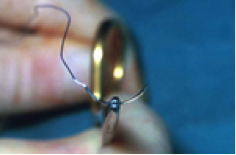 |
Sutures and Closures
Sutures
SIZE refers to the diameter of the suture strand and is usually expressed by an appropriate number of zeros, in millimetres or as a metric number.
| USP/BP | mm | Metric No | |
| 3/0 | 0.2 | 2 | The zeros system does not uniformly correspond |
| 4/0 | 0.15 | 1.5 | |
| 5/0 | 0.1 | 1 | |
| 6/0 | 0.07 | 0.7 |
Suture material is made into either monofilament (single strand), or multifilament form, which in turn can be twisted or braided, and coated.
Monofilament e.g. PDS (absorbable) Ethilon (non-absorbable)
Advantages – slide through tissue easily, less tissue reaction, memory, cheaper.
Disadvantages – stiffer, knots may slip, more likely to cut out.
Twisted and Braided e.g. Vicryl (absorbable) Nurolon (non-absorbable)
Advantages – easy to handle and knot, good for tying off vessels
Disadvantages – more reaction, infection variable absorption
Absorbable:
Synthetics
Degraded by hydrolysis – Coated, braided, good handling, 50% Strength at Vicryl (Polyglactin 910) 2-3 weeks. May “spit out”.
Dexon (Polyglycolic Acid) – Uncoated, braided, fair handling 50% strength at 2-3 weeks.
P.D.S. (Polydioxanone) – Monofilament. Poor handling, 50% strength at 6 weeks.
Monocryl (Poliglecaprone 25) – Monofilament. Fair handling. Non-reactive. 50% strength at 10 days
Advantages – predictable absorption and strength. Very little tissue reaction. Long lasting strength.
Disadvantages – May “spit out” (especially Vicryl). Present in tissue 3-6 months. Poor handling of P.D.S.
Non-Absorbable:
Nylon
a) Monofilament, e.g. Ethilon, Dermalon
Advantages – high tensile strength, low tissue reaction and infection rate; fewer stitch marks. Excellent for skin surgery. Easy suture removal. Some elasticity. Cheap.
Disadvantages – poor handling and knot security if special knots not used.
b) Braided, e.g. Nurolon, Surgilon
Advantages – easier handling than monofilament
Disadvantages – higher infection rate than monofilament. Expensive.
Polypropylene
Monofilament, e.g. Prolene, Surgilene, Dermalene
Advantages – very smooth surface. Plasticity therefore very little cutting out. Low infection rate. Can be left in position for several weeks.
Disadvantage – poor handling and knot security. More expensive than monofilament nylon.
Polyester
Braided, e.g. Mersilene, Dacron, Ethibond
Advantages – soft and strong. Useful for mouths, mucosae, folds.
Disadvantage – expensive, little advantage over silk.
Polybutester
Monofilament, e.g. Novafil
Advantages – slippery and plastic, ties easily, low tissue reaction.
Disadvantages – poor knot security, expensive.
Silk (Braided)
Advantages – soft, easy to tie. Useful for lips, mouth, body folds etc. Less likely to tear.
Disadvantages – marked tissue reaction, stitch marks, high rate of infection, painful suture removal. Must be removed by 4 days to avoid scarring. Now largely superseded by synthetics.
Cyanoacrylate closures
Cyanoacrylate can be used to close wounds when the edges are in apposition and there is no tension present. They can be used on their own or between interrupted sutures. Currently the two products available are Histacryl (?) and Dermabond (Ethicon).
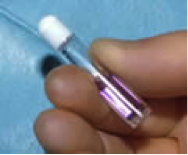 |
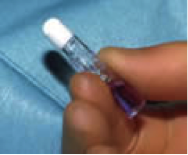 |
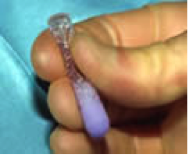 |
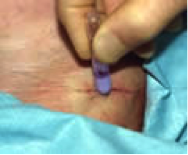 |
